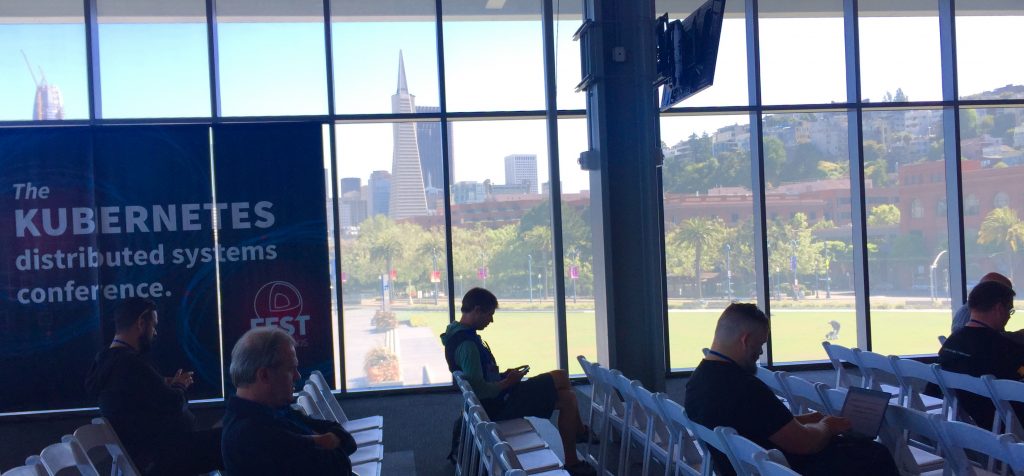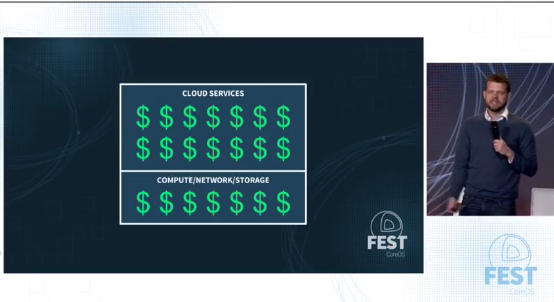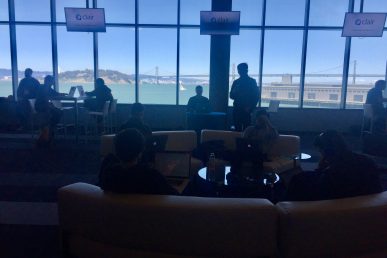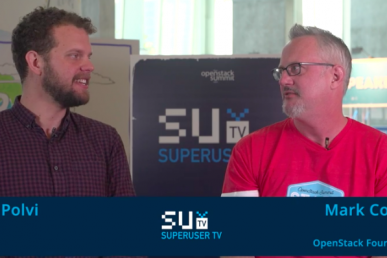SAN FRANCISCO — Punk bands don’t have slick marketing campaigns. They have friends who go around stapling handmade fliers and silkscreen their own t-shirts in the garage. What they don’t have in money, they make up with help from their friends and lot of elbow grease.
Taking that ethos to open source — but getting the band a tour and on Spotify — is what’s next for CoreOS. On the opening keynote for CoreOS Fest 2017, Brian Harrington, the head of infrastructure at CoreOS, kicked things off taking about his own past in a punk band and how “CoreOS has really pushed the industry forward, building one piece at a time…”
Join us live from #CoreOSFest and watch the keynotes now https://t.co/zzOIT4iRQR – first up, Redbeard from CoreOS opens up the event. pic.twitter.com/8fillc3mHM
— CoreOS, Inc. (@coreos) May 31, 2017
Then it was CEO Alex Polvi’s turn to re-iterate the message in a more enterprise-friendly version. “Every shift in infrastructure promised more efficiency, reliability, agility etc.,” he says, “but every single one has resulted in a massive proprietary software vendor that has undermined all the work from free software communities. We believe that cloud is beginning to look just as restrictive.”

He delivered the main message for the third edition of CoreOS Fest from the top floor of Pier 27, usually home to docking cruise ships and some amazing views. “The key is closing the gap between upstream open source and the operational benefits of the cloud. We’re not locking you in to these services. It’s the future of our company and the future of cloud,” he said.
The $25 demo
The higher order services are the real issue — databases, queues, etc — once you start using them, you have to pay hourly bill or your apps just turn off. “The value proposition — ease of management, ease of consumption – is so high that you just throw everything out the window. What you don’t realize is that a year or two in, the bill’s through the roof and there’s nothing you can do about it.”

Polls says CoreOS aims to end the cycle with Tectonic, offering both the benefits of cloud services and the freedom that open source software provides. He cited a 451 Research report that 71 percent of enterprises are using Kubernetes because they want cross-capabilities. There’s a spectrum — that runs between automated operations and what he calls the “openness access of openness” – and how free users are to run applications in any environment.
He says it’s an “industry-defining moment,” and cloud services not coupled to infrastructure will be the future. Polvi reminded the sold-out crowd that “open-source products have become really good. Don’t be afraid to choose them,” then demoed what you can do with an individual container and a couple of apps running on Kubernetes. He showed that cost him just $25 to run the demo over the course of a few days, adding “it’s all possible right now, and I encourage you to check it out.” The question of whether you can have the benefits of cloud service providers and the openness and flexibility of free software — and the answer is a resounding “yes.”
The demo-rich keynote segued into showing “etcd as-a-service” (Polvi flipped from AWS West and used an etcd cluster to deploy a new one) and Container Linux Operator as a base container with Tectonic (“probably the hardest piece of software we’ve ever built as a company”) that provides automated operations that expand to the node’s Container Linux operating system and etcd services. It currently works on Amazon, Azure, bare metal and with more to come.
Enjoying the @polvi pitch and demos at #coreosfest. Etcd as a service is interesting. @brianredbeard is a master assistant, naturally. pic.twitter.com/nkgcHo3yGf
— Mark Collier (@sparkycollier) May 31, 2017
Microsoft sets sail with Draft
After all the talk of breaking the shackles of proprietary software, it was the turn of Microsoft’s Gabe Monroy to take the stage. Clad (armored?) in a Linux Foundation vest, he launched Draft. (Keeping the Kubernetes (or “helm”) nautical metaphor moving, it takes the name from the draft or draught of a ship’s hull — the distance between the waterline and the bottom of the hull.) Draft is a 100 percent open-source software that works with any Kubernetes deployment, meant to help devs streamline creating cloud-native applications on Kubernetes. Despite the change in tone, his demo hit a positive note.
As much as I’ve been in a heavy anti-Microsoft mood over the past couple of years, this is darn cool https://t.co/YInf3IR8JL #CoreOSFest
— Christian Frichot (@xntrik) May 31, 2017
That demo was *sweet*. Active dev auto-deploying on a Tectonic cluster as local files were changed #coreosfest https://t.co/vFJWjLd78h
— Hart Hoover (@hhoover) May 31, 2017
Betting the farm on Kubernetes and Borg
Polvi then brought up a panel of customers, people who are “betting the farm on Kubernetes.”
#CoreOSFest keynote panel: CoreOS customers @Concur, @Nike, @Starbucks, & @tmTech share their thoughts on containers and #Kubernetes pic.twitter.com/YwkAePdziH
— CoreOSfest (@coreosfest) May 31, 2017
A few highlights:
- Justin Dean, Ticketmaster. The biggest impact for his company right now “is the website. There are hundreds of different components… All the new stuff is running on Kubernetes and Tectonic.” The cultural shift was their biggest gain: “resiliency monitorability repeatability, all have to be correct to live in a container wold.” The pair up works for them because “we don’t want to build ticketmasternetes.”
- Scott Ames, Starbucks. The coffee giant chose it over, say Mesos, because “both bring a lot to the table. Kubernetes translated well from development to production for us. We were looking for something that could take us to next level and Tectonic did that.”
- Ilya Borisov, of corporate travel company Concur, highlighted the importance of Quay — the CoreOS hosted and enterprise Docker container registry — to his team saying that “security is vital.”
John Wilkes on stage at #coreosfest shares the history of distributed systems at Google with Borg, Omega, and #Kubernetes pic.twitter.com/ISh49CQwJL
— CoreOSfest (@coreosfest) May 31, 2017
The keynote wound up with a talk from John Wilkes from Google Cloud, who shared the history of distributed systems at Google with Borg and Omega. Wilkes started off saying that he wants to continue to bring our experience into Kubernetes so that the mistakes he and his team made don’t repeat themselves. While he said that “Kubernetes is already composable in a way that Borg never was, he made a point of saying that “developers need to focus on business features not on infrastructure.”
- OpenStack Homebrew Club: Meet the sausage cloud - July 31, 2019
- Building a virtuous circle with open infrastructure: Inclusive, global, adaptable - July 30, 2019
- Using Istio’s Mixer for network request caching: What’s next - July 22, 2019

)










